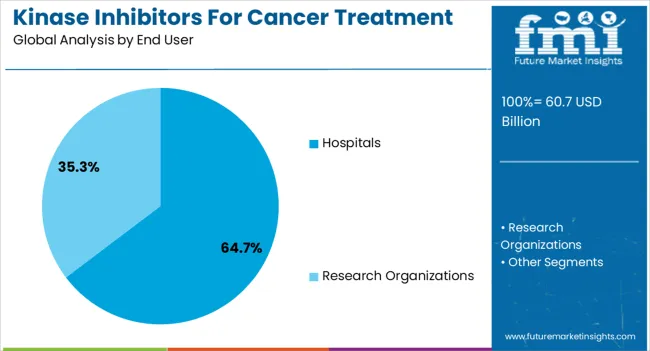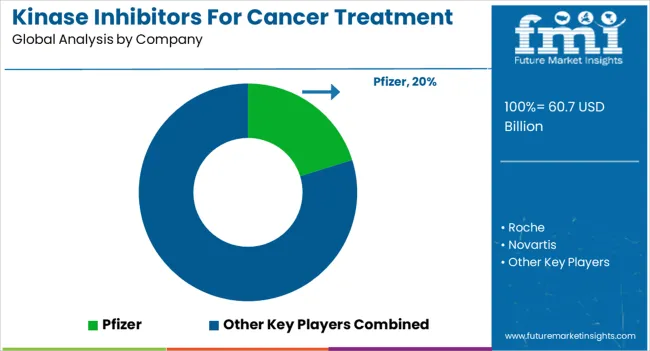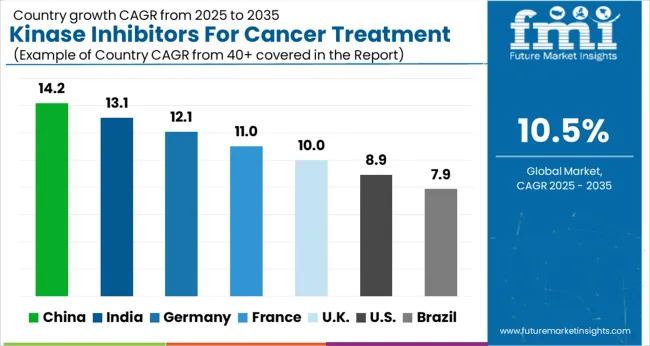The Kinase Inhibitors For Cancer Treatment Market is estimated to be valued at USD 60.7 billion in 2025 and is projected to reach USD 164.8 billion by 2035, registering a compound annual growth rate (CAGR) of 10.5% over the forecast period.
https://futurecrm.futuremarketinsights.com/reports/upload_report_images
| Metric | Value |
|---|---|
| Kinase Inhibitors For Cancer Treatment Market Estimated Value in (2025 E) | USD 60.7 billion |
| Kinase Inhibitors For Cancer Treatment Market Forecast Value in (2035 F) | USD 164.8 billion |
| Forecast CAGR (2025 to 2035) | 10.5% |
The kinase inhibitors for cancer treatment market is experiencing strong expansion, supported by the increasing prevalence of cancer and the rising adoption of targeted therapies across major healthcare systems. Unlike conventional chemotherapies, kinase inhibitors offer selective action against specific molecular pathways, thereby reducing systemic toxicity and improving patient outcomes. Advances in biomarker research and companion diagnostics are enabling the identification of patients who are most likely to respond to these therapies, which is accelerating their integration into treatment regimens.
The growing pipeline of kinase inhibitor drugs across multiple oncology indications is further enhancing the market outlook. Patent expirations of several first-generation inhibitors are opening avenues for generics, making treatments more accessible in emerging economies.
Regulatory agencies are prioritizing fast-track approvals for innovative therapies, reinforcing growth opportunities for manufacturers With continuous investment in oncology research, strategic collaborations between biopharmaceutical companies, and increasing awareness among healthcare providers, the kinase inhibitors market is projected to maintain a strong growth trajectory over the coming years, establishing itself as a key driver in precision oncology.
The kinase inhibitors for cancer treatment market is segmented by product type, end user, and geographic regions. By product type, kinase inhibitors for cancer treatment market is divided into EGFR inhibitors, Angiogenesis inhibitors, m-TOR inhibitors, BRAF and MEK inhibitors, Bcr-Abl tyrosine-kinase inhibitors (TKI), and Others (PI3K Inhibitors, aurora-kinase inhibitors etc). In terms of end user, kinase inhibitors for cancer treatment market is classified into Hospitals and Research Organizations. Regionally, the kinase inhibitors for cancer treatment industry is classified into North America, Latin America, Western Europe, Eastern Europe, Balkan & Baltic Countries, Russia & Belarus, Central Asia, East Asia, South Asia & Pacific, and the Middle East & Africa.

The EGFR inhibitors segment is projected to hold 32.5% of the kinase inhibitors for cancer treatment market revenue share in 2025, positioning it as the leading product type. Its dominance is being supported by the high prevalence of cancers associated with epidermal growth factor receptor mutations, particularly in lung and colorectal cancers. EGFR inhibitors have demonstrated significant efficacy in slowing tumor progression and improving survival outcomes, which has reinforced their role as frontline therapies in targeted cancer treatment.
Advancements in next-generation inhibitors are addressing drug resistance, ensuring sustained therapeutic effectiveness even in advanced disease stages. The growing body of clinical evidence validating the benefits of EGFR-targeted therapy is further enhancing its acceptance among oncologists.
Expanded approval of these drugs across multiple cancer types and the availability of oral formulations are contributing to patient compliance and adoption With ongoing research focused on improving specificity and minimizing adverse effects, the EGFR inhibitor segment is expected to maintain its leadership position in the kinase inhibitors market over the forecast period.

The hospitals segment is anticipated to account for 64.7% of the kinase inhibitors for cancer treatment market revenue share in 2025, establishing itself as the leading end user. This dominance is being reinforced by the critical role hospitals play in administering advanced oncology therapies, conducting diagnostic testing, and managing complex cancer care pathways. Hospitals serve as primary centers for the initiation of targeted treatment regimens, where multidisciplinary teams can monitor patient response and adjust therapy as needed.
The presence of advanced infrastructure, clinical trial facilities, and access to specialized oncology expertise in hospitals is driving their central role in the adoption of kinase inhibitors. Increasing government and private sector investments in expanding cancer treatment facilities are also contributing to higher uptake.
Furthermore, hospitals are at the forefront of integrating precision medicine approaches, leveraging biomarker testing to personalize therapy The ability to deliver comprehensive care, from diagnosis to treatment and follow-up, has positioned hospitals as the dominant setting for kinase inhibitor administration and will continue to reinforce their leadership moving forward.
However, the high cost associated with the treatment might affect the market growth. Apart from that, the complex process pertaining to approvals from regulatory authorities might cause further inhibitions going ahead.
Moreover, the patient who undergoes kinase inhibitors for cancer treatment might experience certain side effects like nausea, vomiting, diarrhoea, fatigue, rashes, etc. This as well is expected to challenge the adoption of kinase inhibitors for cancer treatment during the forecast period.
On the basis of regional analysis, it was found that Europe had the largest market share. The growing geriatric population, coupled with major technological advancements in the healthcare sector, is currently driving the Europe market.
North America is expected to showcase massive development during the forecast period. The region currently has the largest healthcare market and is expected to grow by leaps and bounds.
However, if we talk about the fastest-growing market, it would be Asia-Pacific. Increased investment by the governments and various healthcare authorities in the region, coupled with an improving healthcare infrastructure, is expected to surge the kinase inhibitors for the cancer treatment market during the forecast period.
Based on the end user, the hospital segment is expected to have the highest market share during the forecast period. An increasing number of cancer patients getting admitted to hospitals happens to be the major reason why the segment is expected to have the highest market share.
In October 2025, researchers from the UVA Health Care Center developed an algorithm that will improve cancer care by quickly and efficiently identifying patients who will benefit from the application of kinase inhibitors.
Enhancedemphasis of pharmaceutical companies on R&D to come up with potential kinase inhibitors for treatment of cancers. Is driving the growth of kinase inhibitor treatment market, globally.
Presently,kinase inhibitors for cancer treatmentglobal market is driven by some of the factors like technological progression in healthcare area, rise in the prevalence of cancer patients around the globe and rise in the incidence of chronic disease.
However, high cost associated with latest clinical trials and complex approvals processes are acting as a major obstructions for the growth of kinase inhibitors for cancer treatmentglobal market.
The global market for kinase inhibitors for cancer treatmentis expected to register a healthy CAGR during the forecast period. There are reasons for healthy growth rate in the forecast period such asfast technological development, upsurge in the number of incidence of cancer patients, rise in the increasing adverse effects from chemotherapy and increase in the prevalence of cancer patients around the globe
Depending on geographic regions, kinase inhibitors for cancer treatment market is segmented into seven key regions: North America, Latin America, Eastern Europe, Western Europe, Asia Pacific Excluding Japan, Japan and Middle East & Africa.
In terms of region Europe accounts for the largest market shares in global kinase inhibitors for cancer treatment market owing to advancements in medical research, clinical trials, growing geriatric population with cancer indication.
Whereas, North America and Asia-Pacific is projected showing a healthy CAGR during the forecast period, 2025-2026 owing to increasing incidence and prevalence of cancer patients. Thereby, contribute to the growth of global kinase inhibitors for cancer treatmentmarket value.
The market for kinase inhibitors for cancer treatmentin various regions is particularly driven by gradually increasing awareness, rising incidence of cancer patients and adoption of advanced technologies in cancer treatment.

Some of the key participating global players in kinase inhibitors for cancer treatment global market are Pfizer Inc., Boehringer Ingelheim GmbH, Novartis AG, Incyte Corporation, MedImmune, AstraZeneca, Eisai Co., Ltd., Takeda Pharmaceutical Company Limited and others.
The research report presents a comprehensive assessment of the market and contains thoughtful insights, facts, historical data, and statistically supported and industry-validated market data. It also contains projections using a suitable set of assumptions and methodologies.
The research report provides analysis and information according to categories such as market segments, geographies, types, technology and applications.
The report is a compilation of first-hand information, qualitative and quantitative assessment by industry analysts, inputs from industry experts and industry participants across the value chain. The report provides in-depth analysis of parent market trends, macro-economic indicators and governing factors along with market attractiveness as per segments. The report also maps the qualitative impact of various market factors on market segments and geographies.

| Country | CAGR |
|---|---|
| China | 14.2% |
| India | 13.1% |
| Germany | 12.1% |
| France | 11.0% |
| UK | 10.0% |
| USA | 8.9% |
| Brazil | 7.9% |
The Kinase Inhibitors For Cancer Treatment Market is expected to register a CAGR of 10.5% during the forecast period, exhibiting varied country level momentum. China leads with the highest CAGR of 14.2%, followed by India at 13.1%. Developed markets such as Germany, France, and the UK continue to expand steadily, while the USA is likely to grow at consistent rates. Brazil posts the lowest CAGR at 7.9%, yet still underscores a broadly positive trajectory for the global Kinase Inhibitors For Cancer Treatment Market. In 2024, Germany held a dominant revenue in the Western Europe market and is expected to grow with a CAGR of 12.1%. The USA Kinase Inhibitors For Cancer Treatment Market is estimated to be valued at USD 22.6 billion in 2025 and is anticipated to reach a valuation of USD 53.2 billion by 2035. Sales are projected to rise at a CAGR of 8.9% over the forecast period between 2025 and 2035. While Japan and South Korea markets are estimated to be valued at USD 3.2 billion and USD 1.5 billion respectively in 2025.
| Item | Value |
|---|---|
| Quantitative Units | USD 60.7 Billion |
| Product Type | EGFR inhibitors, Angiogenesis inhibitors, m-TOR inhibitors, BRAF and MEK inhibitors, Bcr-Abl tyrosine-kinase inhibitors (TKI), and Others (PI3K Inhibitors, aurora-kinase inhibitors etc) |
| End User | Hospitals and Research Organizations |
| Regions Covered | North America, Europe, Asia-Pacific, Latin America, Middle East & Africa |
| Country Covered | United States, Canada, Germany, France, United Kingdom, China, Japan, India, Brazil, South Africa |
| Key Companies Profiled | Pfizer, Roche, Novartis, Eli Lilly and Company, AstraZeneca, Merck, Bayer, Takeda Pharmaceutical, Bristol Myers Squibb, Incyte, Eisai, and Boehringer Ingelheim |
The global kinase inhibitors for cancer treatment market is estimated to be valued at USD 60.7 billion in 2025.
The market size for the kinase inhibitors for cancer treatment market is projected to reach USD 164.8 billion by 2035.
The kinase inhibitors for cancer treatment market is expected to grow at a 10.5% CAGR between 2025 and 2035.
The key product types in kinase inhibitors for cancer treatment market are egfr inhibitors, angiogenesis inhibitors, m-tor inhibitors, braf and mek inhibitors, bcr-abl tyrosine-kinase inhibitors (tki) and others (pi3k inhibitors, aurora-kinase inhibitors etc).
In terms of end user, hospitals segment to command 64.7% share in the kinase inhibitors for cancer treatment market in 2025.






Full Research Suite comprises of:
Market outlook & trends analysis
Interviews & case studies
Strategic recommendations
Vendor profiles & capabilities analysis
5-year forecasts
8 regions and 60+ country-level data splits
Market segment data splits
12 months of continuous data updates
DELIVERED AS:
PDF EXCEL ONLINE
Kinase Inhibitor in Autoimmune Diseases Market Size and Share Forecast Outlook 2025 to 2035
Janus Kinase (JAK) Inhibitors Market
Protein Kinase B Inhibitors Market
Creatine Kinase Reagent Market Size and Share Forecast Outlook 2025 to 2035
Combination Kinase Inhibitor Market Analysis - Size, Share, and Forecast Outlook 2025 to 2035
Cyclin-Dependent Kinase Inhibitor Market Size and Share Forecast Outlook 2025 to 2035
Bruton's Tyrosine Kinase (BTK) Inhibitors Market
FcRn Inhibitors Market Size and Share Forecast Outlook 2025 to 2035
CGRP Inhibitors Market Trends - Growth, Demand & Forecast 2025 to 2035
SGLT2 Inhibitors Market Size and Share Forecast Outlook 2025 to 2035
NF-KB Inhibitors Market
Mould Inhibitors Market
SGLT2 Inhibitors Treatment Market Overview – Trends & Growth 2024-2034
Enzyme Inhibitors Market
Paraffin Inhibitors Market
Corrosion Inhibitors Market Growth - Trends & Forecast 2025 to 2035
PD-1/PD-L1 Inhibitors Market – Trends, Growth & Forecast 2025 to 2035
Proton Pump Inhibitors Market Insights - Demand, Size & Industry Trends 2025 to 2035
Angiopoietin Inhibitors Therapeutic Market
Small Molecule Inhibitors Market Analysis – Size, Share, and Forecast Outlook 2025 to 2035

Thank you!
You will receive an email from our Business Development Manager. Please be sure to check your SPAM/JUNK folder too.
Chat With
MaRIA